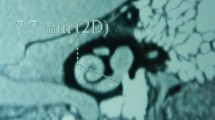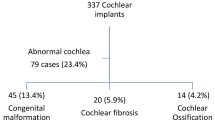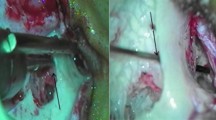Abstract
To test whether there are variations in cochlear orientation with respect to age and sex, and its relevance in cochlear implant surgery. Implant otologists rely upon the anatomic landmarks including the facial recess and round window niche and round window membrane for accessibility and placement of electrode array into scala tympani of basal turn of cochlea. Anecdotally, surgeons note variations in cochlear orientation with respect to age. Cochlear orientation studied radiologically by pre-operative CT scan of temporal bone can guide a Surgeon’s approach to cochlear implantation. To investigate the changes in cochlear orientation with respect to age and sex; and its relevance in cochlear implantation. A retrospective analytical study was performed on CT scans of temporal bones in patients (of our hospital from July 2013 to January 2015 i.e. for a period of 18 months) with no congenital or radiological abnormalities of cochlea. The basal turn angulations of cochlea varied with age and majority of change occurred during early age. The basal turn angulations of cochlea in difficult situations during cochlear implantation were correlated with the data. There is a significant variation in cochlear orientation as measured radiologically by basal turn angulations relative to midsagittal plane. The more obtuse and acute basal turn angulations have implications like difficulty in cochleostomy and electrode placement during cochlear implantation.












Similar content being viewed by others
References
Jeffery N, Spoor F (2004) Prenatal growth and development of the modern human labyrinth. J Anat 204(2):71–92
Erixon E, Hogstorp H, Wadin K, Rask-Andersen H (2009) Variational anatomy of the human cochlea: implications for cochlear implantation. Otol Neurotol 30(1):14–22
Lloyd SKW, Kasbekar AV, Kenway B et al (2010) Developmental changes in cochlear orientation—implications for cochlear implantation. Otol Neurotol 31:902–907
Theodore R, Rackan Mc, Fitsum A et al (2012) Comparision of cochlear implant relevant anatomy in children versus adults. Otol Neurotol 33:328–334
Bast TH (1942) Development of the otic capsule. VI. Histological changes and variations in the growing bony capsule of the vestibule and cochlea. Ann Otol Rhinol Laryngol 51:343–357
Siebenmann F (1890) Die Korosions-Anatomie Des Knochernan Labyrinthes Des Menschlichen Ohres. Bergmann, J.F, Wiesbaden
Schonemann A (1906) Schlafenbein und Schadelbasis, eine anatomischotiatrische Studie. N Denkschr algem Schweizer Gesellsch gesamt Naturwiss 40:95–160
Hyrtl J (1845) Vergleichend-Anatomische Untersuchungen Uber das Innere Gehororgan Des Menschen und der Saugethiere. Prague, Ehrlich, F.
Sercer A, Krmpotic J (1958) Further contributions to the development of the labyrinthine capsule. J Laryngol Otol 72:688–698
Zehnder AF, Kristiansen AG, Adams JC et al (2006) Osteoprotegrin knockout mice demonstrate abnormal remodeling of the otic capsule and progressive hearing loss. Laryngoscope 116:201–206
Farkas LG, Posnick JC, Hreczko TM (1992) Anthropometric growth study of the head. Cleft Palate Craniofac J 29:303–308
Richtsmeier JT, Cheverud JM (1986) Finite element scaling analysis of human craniofacial growth. J Craniofac Genet Dev Biol 6:289–323
Eby TL, Nadol JB Jr (1986) Postnatal growth of the human temporal bone. Implications for cochlear implants in children. Ann Otol Rhinol Laryngol 95:356–364
Paprocki A, Biskup B, Kozlowska K et al (2004) The topographical anatomy of the round window and related structures for the purpose of cochlear implant surgery. Folia Morphol (Warsz) 63(3):309–312
Stjernholm C (2003) Aspects of temporal bone anatomy and pathology in conjunction with cochlear implant surgery. Acta Radiol 44(Suppl 430):2–15
Seicshnaydre MA, Johnson MH, Hasenstab MS, Williams GH (1992) Cochlear implants in children: reliability of computed tomography. Otolaryngol Head Neck Surg 107(3):410–417
Nikolopoulos TP, O’Donoghue GM, Robinson KL et al (1997) Preoperative radiologic evaluation in cochlear implantation. Am J Otol 18(6 Suppl):S73–S74
Verbist BM, Joemai RM, Briaire JJ et al (2010) Cochlear coordinates in regard to cochlear implantation: a clinically individually applicable 3 dimensional CT-based method. Otol Neurotol 31(5):738–744
Martinez-Monedero R, Niparko JK et al (2011) Cochlear coiling pattern and orientation differences in cochlear implant candidates. Otol Neurotol 32(7):1086–1093
Escude B, James C, Deguine O et al (2006) The size of the cochlea and predictions of insertion depth angles for cochlear implant electrodes. Audiol Neurotol 11(1 Suppl):27–33
Acknowledgements
The authors thank the subjects and the staff in the department of Radiology and ENT at Christian Medical College, for all their assistance and support. This article was derived during Post doctoral fellowship in Implant Otology at Christian Medical College, Vellore, India.
Author information
Authors and Affiliations
Corresponding author
Ethics declarations
Conflict of interest
The authors declare that they have no conflict of interest.
Ethical Approval
The above study was approved by Institutional Review Board (IRB) of Christian Medical College and the consent was waived because the High Resolution CT scans of the temporal bones were done for various reasons (not just for study purpose and did not financially impact the study population), from which the necessary data was extracted from radiology department.
Rights and permissions
About this article
Cite this article
Kiran, A.S., Varghese, A.M., Irodi, A. et al. Radiological Evaluation of Cochlear Orientation and Its Implications in Cochlear Implantation. Indian J Otolaryngol Head Neck Surg 70, 1–9 (2018). https://doi.org/10.1007/s12070-017-1173-7
Received:
Accepted:
Published:
Issue Date:
DOI: https://doi.org/10.1007/s12070-017-1173-7




